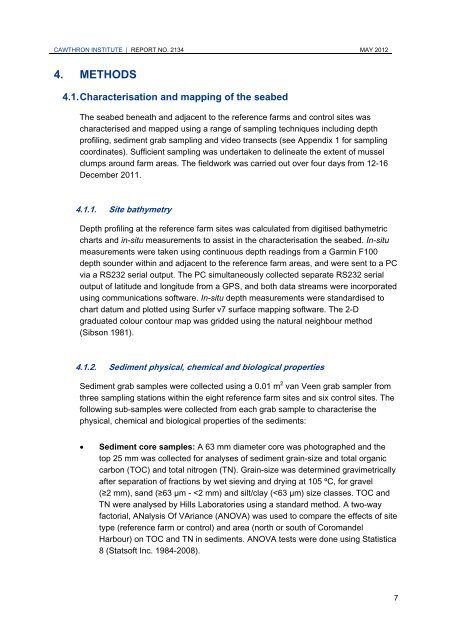Application 124771 - Ministry of Fisheries
Application 124771 - Ministry of Fisheries
Application 124771 - Ministry of Fisheries
You also want an ePaper? Increase the reach of your titles
YUMPU automatically turns print PDFs into web optimized ePapers that Google loves.
CAWTHRON INSTITUTE | REPORT NO. 2134 MAY 2012<br />
4. METHODS<br />
4.1. Characterisation and mapping <strong>of</strong> the seabed<br />
The seabed beneath and adjacent to the reference farms and control sites was<br />
characterised and mapped using a range <strong>of</strong> sampling techniques including depth<br />
pr<strong>of</strong>iling, sediment grab sampling and video transects (see Appendix 1 for sampling<br />
coordinates). Sufficient sampling was undertaken to delineate the extent <strong>of</strong> mussel<br />
clumps around farm areas. The fieldwork was carried out over four days from 12-16<br />
December 2011.<br />
4.1.1. Site bathymetry<br />
Depth pr<strong>of</strong>iling at the reference farm sites was calculated from digitised bathymetric<br />
charts and in-situ measurements to assist in the characterisation the seabed. In-situ<br />
measurements were taken using continuous depth readings from a Garmin F100<br />
depth sounder within and adjacent to the reference farm areas, and were sent to a PC<br />
via a RS232 serial output. The PC simultaneously collected separate RS232 serial<br />
output <strong>of</strong> latitude and longitude from a GPS, and both data streams were incorporated<br />
using communications s<strong>of</strong>tware. In-situ depth measurements were standardised to<br />
chart datum and plotted using Surfer v7 surface mapping s<strong>of</strong>tware. The 2-D<br />
graduated colour contour map was gridded using the natural neighbour method<br />
(Sibson 1981).<br />
4.1.2. Sediment physical, chemical and biological properties<br />
Sediment grab samples were collected using a 0.01 m 2 van Veen grab sampler from<br />
three sampling stations within the eight reference farm sites and six control sites. The<br />
following sub-samples were collected from each grab sample to characterise the<br />
physical, chemical and biological properties <strong>of</strong> the sediments:<br />
Sediment core samples: A 63 mm diameter core was photographed and the<br />
top 25 mm was collected for analyses <strong>of</strong> sediment grain-size and total organic<br />
carbon (TOC) and total nitrogen (TN). Grain-size was determined gravimetrically<br />
after separation <strong>of</strong> fractions by wet sieving and drying at 105 ºC, for gravel<br />
(≥2 mm), sand (≥63 μm -
















